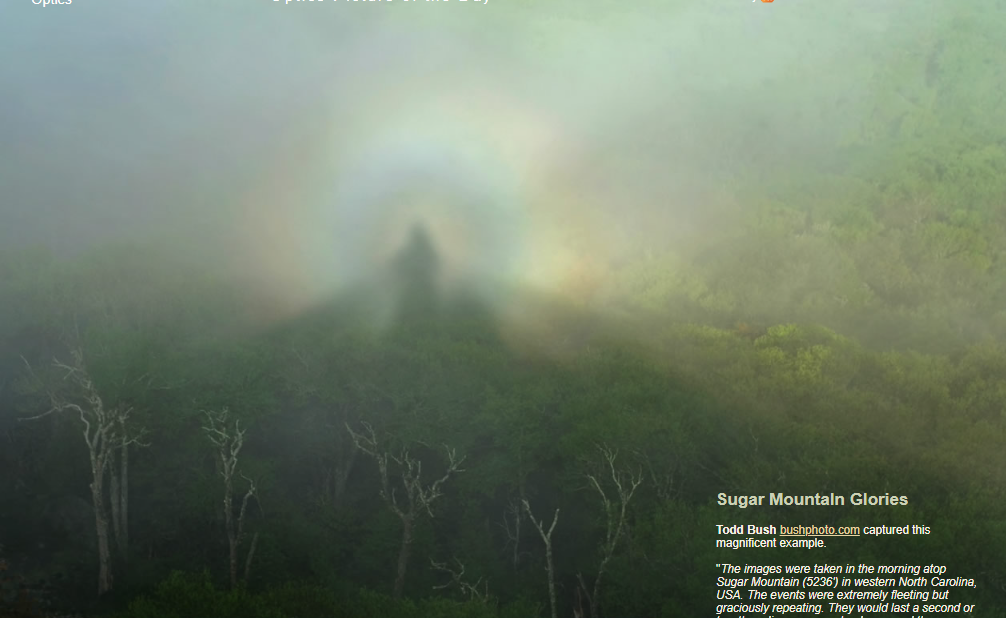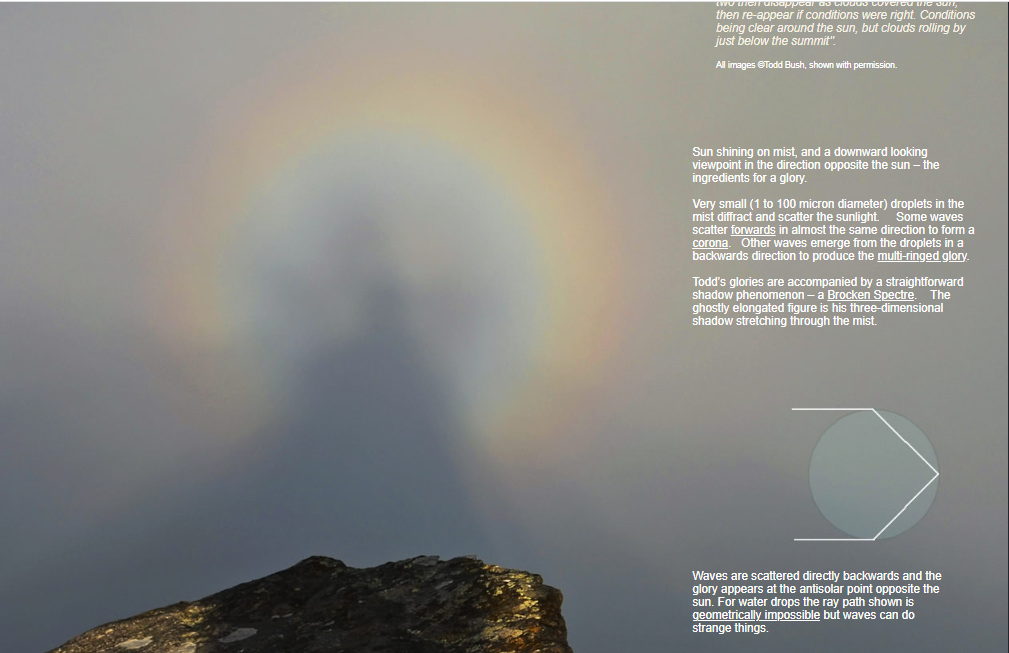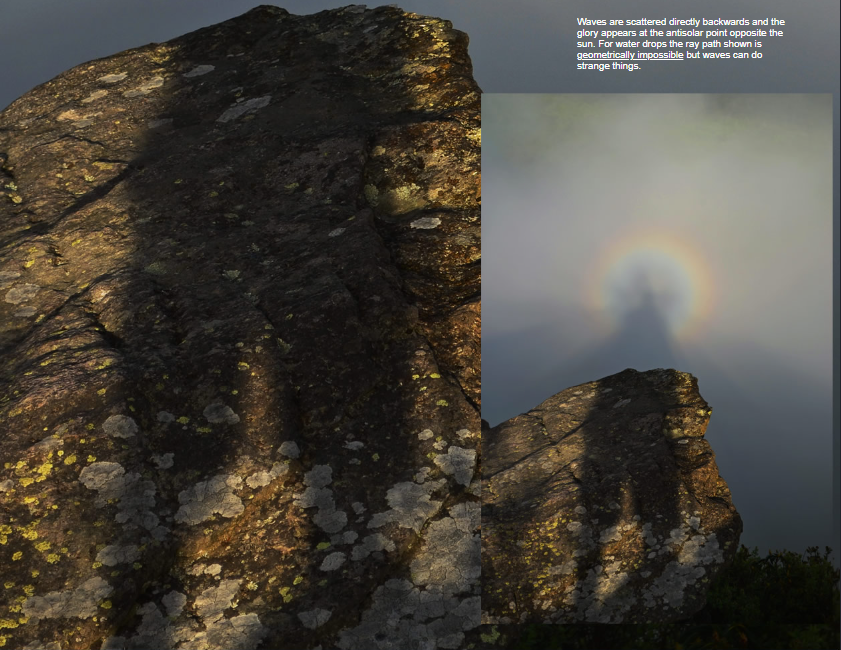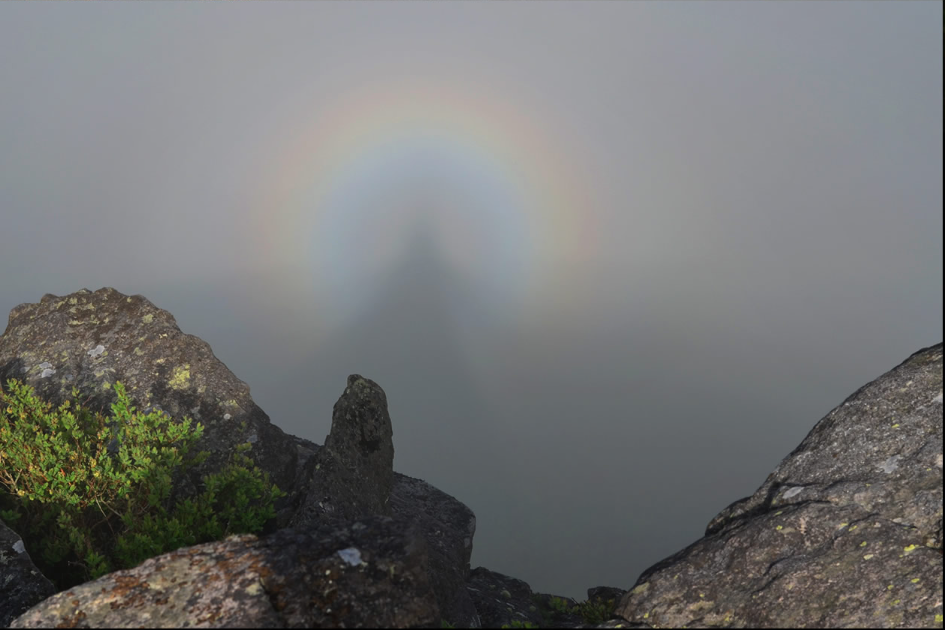OPOD - Sugar Mountain Glories
OPOD - Sugar Mountain Glories: A Spectacular Atmospheric Phenomenon
Have you ever witnessed a breathtaking optical display in the sky that seemed to appear and disappear within seconds? Todd Bush, an avid photographer, captured one such magnificent phenomenon atop Sugar Mountain (5236') in western North Carolina, USA. These fleeting yet captivating events, known as "Sugar Mountain Glories," mesmerize observers with their ethereal beauty. In this article, we will delve deeper into the science behind these glorious spectacles and explore the intricate interplay of light, mist, and shadows.
The Ingredients of a Glory
To understand the formation of Sugar Mountain Glories, we need to examine the specific conditions required for their occurrence. Firstly, sunlight must shine on a mist or cloud layer, providing the necessary illumination. Secondly, the observer's viewpoint should be directed downward, opposite to the position of the sun. These two elements set the stage for the glory to unfold.
The Role of Droplets and Sunlight
The primary actors in the creation of a glory are minuscule droplets suspended in the mist. Ranging in size from 1 to 100 microns in diameter, these droplets diffract and scatter sunlight. As the sunlight passes through these droplets, waves scatter forwards in a nearly identical direction, forming a corona. Simultaneously, other waves emerge from the droplets in a backward direction, resulting in the formation of a multi-ringed glory.
The Enigmatic Brocken Spectre
Accompanying Todd's glories is an additional shadow phenomenon known as the Brocken Spectre. This ghostly figure is Todd's three-dimensional shadow elongated through the mist. Waves are scattered directly backward, causing the glory to appear at the antisolar point, which is opposite to the position of the sun. While this backward ray path seems geometrically impossible for water droplets, waves possess the ability to behave in peculiar ways, leading to these intriguing optical effects.
The Transient Nature of Sugar Mountain Glories
One of the captivating aspects of Sugar Mountain Glories is their transient nature. These ethereal spectacles last only for a brief moment, typically a second or two, before vanishing. The ephemeral nature of the glories arises from the interplay of atmospheric conditions. Clear skies around the sun provide the necessary clarity for sunlight to pass through the droplets and create the glory. However, as clouds roll by just below the summit, they intermittently obstruct the sunlight, causing the glories to appear and disappear rhythmically.
Exploring the Captivating Images
Todd Bush's photographs beautifully capture the essence of Sugar Mountain Glories. The images showcase the vibrant colors and intricate ring structures that characterize these atmospheric phenomena. Through his lens, we can witness the sheer magnificence of these fleeting moments, evoking a sense of wonder and awe.
Conclusion
The enchanting Sugar Mountain Glories offer us a glimpse into the remarkable interplay between light, mist, and shadows in our atmosphere. Understanding the science behind these optical phenomena enhances our appreciation for the natural world and its ability to create breathtaking displays. Todd Bush's stunning photographs serve as a testament to the ethereal beauty that can be found in even the most fleeting moments. So, keep your eyes on the sky, for you never know when you might be fortunate enough to witness the magic of Sugar Mountain Glories.

Sugar MountaIn Glories
Todd Bush bushphoto.com captured this magnificent example.
"The images were taken in the morning atop Sugar Mountain (5236') in western North Carolina, USA. The events were extremely fleeting but graciously repeating. They would last a second or two then disappear as clouds covered the sun, then re-appear if conditions were right. Conditions being clear around the sun, but clouds rolling by just below the summit".
All images ©Todd Bush, shown with permission.

Sun shining on mist, and a downward looking viewpoint in the direction opposite the sun – the ingredients for a glory.
Very small (1 to 100 micron diameter) droplets in the mist diffract and scatter the sunlight. Some waves scatter forwards in almost the same direction to form a corona. Other waves emerge from the droplets in a backwards direction to produce the multi-ringed glory.
Todd’s glories are accompanied by a straightforward shadow phenomenon – a Brocken Spectre. The ghostly elongated figure is his three-dimensional shadow stretching through the mist.
Waves are scattered directly backwards and the glory appears at the antisolar point opposite the sun. For water drops the ray path shown is geometrically impossible but waves can do strange things.



Note: this article has been automatically converted from the old site and may not appear as intended. You can find the original article here.
Reference Atmospheric Optics
If you use any of the definitions, information, or data presented on Atmospheric Optics, please copy the link or reference below to properly credit us as the reference source. Thank you!
-
<a href="https://atoptics.co.uk/blog/opod-sugar-mountain-glories/">OPOD - Sugar Mountain Glories</a>
-
"OPOD - Sugar Mountain Glories". Atmospheric Optics. Accessed on November 22, 2024. https://atoptics.co.uk/blog/opod-sugar-mountain-glories/.
-
"OPOD - Sugar Mountain Glories". Atmospheric Optics, https://atoptics.co.uk/blog/opod-sugar-mountain-glories/. Accessed 22 November, 2024
-
OPOD - Sugar Mountain Glories. Atmospheric Optics. Retrieved from https://atoptics.co.uk/blog/opod-sugar-mountain-glories/.